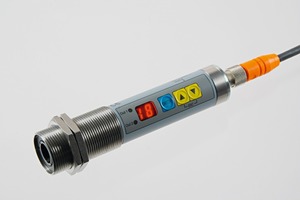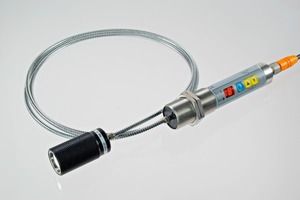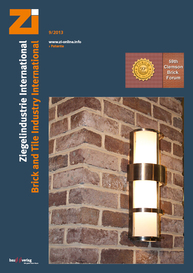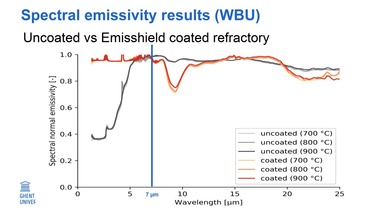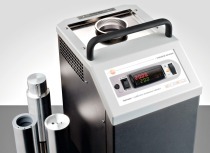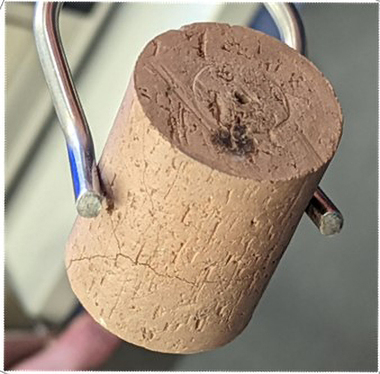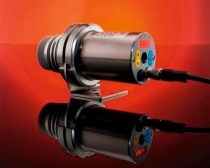CellaSwitch PKS infrared temperature switch
ognizing and counting hot moving objects, measuring their length, determining their positions or breakage, infrared temperature switches are not only ideal, they are often the only feasible option. Without contact and at a safer distance, infrared switches detect the infrared or thermal radiation emitted by an object. A switching process is triggered within milliseconds after the detected temperature exceeds a configured threshold value.
Sensors so far available on the market have proved difficult to configure. Adjusting the threshold switching level is cumbersome. Less sophisticated instruments only feature a preset switching temperature which the user cannot change. Other models let you adjust the signal threshold using a potentiometer voltage divider. The adjustment can only be performed, however, with an adequately hot object present in the sight path.
CellaSwitch, the new infrared temperature switch developed by Keller MSR, features an integrated display panel and control keys. The user selects the exact upper and lower thresholds to trigger switching and can set these values without requiring signal input from a hot object. This is especially convenient, for example, when replacing an infrared temperature switch or when the production process requires the use of several instruments whose settings must match, because the CellaSwitch is simple to adjust to the exact switching point required.
Sensors without a display panel have no way of indicating the temperature of the hot object. The CellaSwitch displays the temperature as a percentage of the measuring span. This value appears as soon as the hot object enters the sensor’s field of view, making it easy for the operator on site to verify the operating state and switching function. The display indicates the difference between the temperature of the hot object and the configured threshold. This is beneficial in determining if atmospheric obstacles such as vapour and dust or a dirty lens are impairing the measurement. If less infrared radiation is reaching the sensor, the instrument will require a higher object temperature in order to trigger the switching function.
The CellaSwitch is equipped with two independently triggering output switches. Settings can be configured directly using the control keys on the instrument. The relay switch contacts can be configured as either normally open or normally closed. This enables various applications such monitoring limit temperatures or temperature spans. The response time can be adjusted by configuring a switch activation delay after the positive (rising) edge of the signal is detected. A deactivation delay is also programmable. This is useful for PLCs with slow scan times to make sure they notice every trigger event.
CellaSwitch features a test input. This allows the user to run a performance check during running operations without requiring a detected hot object. By means of a remote switch or PLC, a thermal heat source in the sensor’s sight path can be simulated to trigger a switching event and thus provide verification of signal processing.
The diagnostics feature enhances operational reliability. The display panel will indicate overcurrent, excess internal temperature, a faulty connection of the supply voltage and upper and lower threshold violations.
Another weakness of many commonly available infrared temperature switches is the poor quality of the optics. To save costs, manufacturers often use simple plastic lenses that have relatively low optical resolution. As a result, these sensors have a large viewing angle. An increase in the distance between the sensor and the target will increase the spot diameter, therefore very small targets can only be measured at short distances. If the target does not completely fill the spot to be measured at the selected distance, the measurement will be inaccurate. The sensor will then not only capture infrared radiation from the hot target object but from the cooler background as well, yielding temperature readings that are too low.
Inferior optical systems are also more susceptible to radiance from unintended heat sources entering the optical path. When stray light reaches the detector, the instrument will report an incorrect temperature. The result: the switching event is shifted depending on the size of the target spot and its distance from the sensor. If a production line produces or processes products of varying size, or if several instruments are employed at different distances, the switching process will be triggered at different temperatures, even when the sensors have been configured identically.
All CellaSwitch series instruments are equipped with superior lenses with anti-reflective coating and high resolution. The sensor is able to detect extremely small target objects and the device can be installed at greater distances. CellaSwitch’s optical system is designed to minimize sensitivity to stray light scattered into the optical path. The switch threshold condition remains constant even when the target size or the distance varies during the process.
The optics of the CellaSwitch features a coated, tempered glass lens which is robust, easy to clean and suitable for harsh industrial environments. The sensor is encased in a rugged, splash-proof, stainless steel housing which provides resistance to vibration and mechanical shock. Thanks to the M30 mounting thread, the CellaSwitch is simple to install.
The CellaSwitch series comprises three models for the temperature ranges 50–500° C, 250–1250° C and 350–1350° C. The CellaSwitch PKS 21 features a fibre optic sensor head. A fibre optic cable transmits the infrared radiation to the separately housed electronics. The small sensor head can be installed in confined spaces, high electromagnetic fields or in environments up to 250° C without requiring cooling. The system offers a wide range of optional accessories such as an air purge, cooling jacket, adjustable mounting bracket, deflection mirror or a thermal insulating tube.
Thanks to the wide temperature ranges, the various switching functions and the high degree of configuration versatility, CellaSwitch is ideal for a wide range of industrial and manufacturing applications. In the ceramics industry, infrared temperature switches are often used to monitor and count the discharge of production units.

